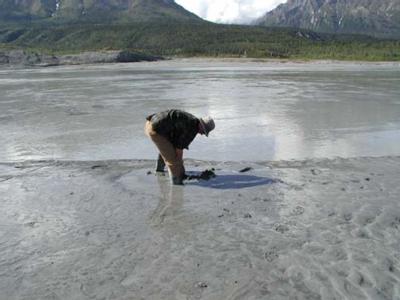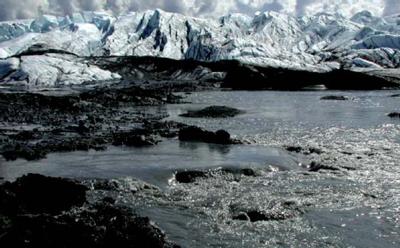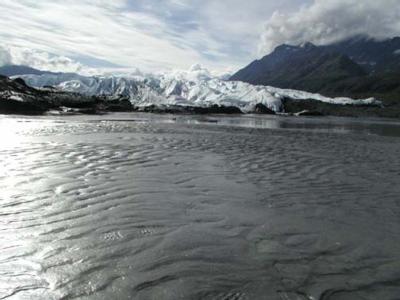24 July, 2000
July 24, 2000
Matanuska Glacier, Alaska
The great weather has stayed with us for yet another day. It was a
beautiful day to be on the ice a long time and the sunshine felt warmer
than ever today. We had another couple of REU students assisting us with
our work today, Isaac Larsen and Jessica Allewalt. At one point I had to
go help Isaac get out of some muck that he got stuck in. We were
sampling from a different vent than we had before and it comes out about
50 feet from the shoreline of some very wet loess beds. Loess is the
very fine sediment formed by the scraping rocks in the glacier. It is
easily suspended in water (glacial flour) and makes the waters very
gray. It forms thick layers as it settles around the lake formed by the
Mammoth Vents. Earlier this month these beds had been under water but
the recent cooler weather has reduced melting and the resulting water
levels are down significantly. In certain parts it will hold you up
really well but in others it seems to suck you right in. I was standing
taking a picture near the edge today when all of a sudden my right foot
sunk all the way to the knee, covering my boot completely. Oddly enough
the other foot had plenty of support that I could get myself out. Itís
very interesting to walk on and rubber boots are a must. Of course
thereís the uncertainty of whether or not it will hold you up in some
spots and occasionally you must backtrack and try to pull yourself out.
Sometimes as you walk you see the color change as you plant your foot.
Iíve noticed this before on beaches at the ocean where the sand is very
wet. The odd thing is it appears as though your foot causes the loess or
sand to dry up somehow. In other places you can stand on one foot and
with the other foot actually create waves in the loess, sort of like
standing on Jello. Sometimes it tends to form long narrow cracks
underfoot as you apply pressure. There are loess deposits all over the
place here, some of which have been deposited many years ago, and when
itís dry it gets blown easily by the wind. The vehicles we use here are
constantly covered with this fine powdery material. It would be
impossible to keep up with a daily car wash!
We are now using just two ISCO water samplers again and they are both
sampling the Mammoth Vent area. We decided to remove the ISCO from
Mammoth-4 and move it to Mega Vent. This vent is also in the Mammoth
collection of vents but has a pretty high discharge and we want to see
if dye is also coming out there as well. We wanted to keep one existing
ISCO on Mammoth-1 and take samples more frequently (every five minutes
instead of ten) in order to get a more well defined graph, especially
near the two hour mark which gave several little rises in the first dye
run. We decided to start the sampling a half hour later since we didnít
see any dye in the first half hour of samples before. We hope that by
adding the extra half hour at the end that maybe we can determine
whether or not all the dye has left the system without actually taking
more samples than before. If we still see dye in the last samples then
we will sample for a longer time period the next time.
A pretty nice frazil ice terrace has formed at Mammoth-4. In fact the
frazil ice there is starting to become a real problem with the water
samplers. In my July 18 journal I included some pictures of the ice that
had frozen onto one of the collectors. Today they had a really tough
time getting it dislodged from the ice. Ben Cashman actually walked out
onto the ice terrace to try to break it free with a pole. At one point
the ice he was on slowly began to tip over and he quickly jumped back to
the safety of the glacierís ice edge.
Tomorrow we will begin to analyze the samples taken today and go to town
for groceries, laundry and showers. It will be interesting to see if we
duplicate the result at Mammoth-1 and if Mega Vent seems to be connected
as well.
Marvin Giesting

Isaac Larsen tried to dig himself out of the muck but it was too much. A lateral moraine from a previous advance of the glacier can be seen in the background. It is the low flat green ridge extending the full length of the picture.

Water flows over the frazil ice terrace that has formed at Mammoth-4.

Looking over the low, wet loess deposit toward the Mammoth Vent area and the glacier. The highest part of this is maybe four inches above the water level.
Contact the TEA in the field at
.
If you cannot connect through your browser, copy the
TEA's e-mail address in the "To:" line of
your favorite e-mail package.
|
